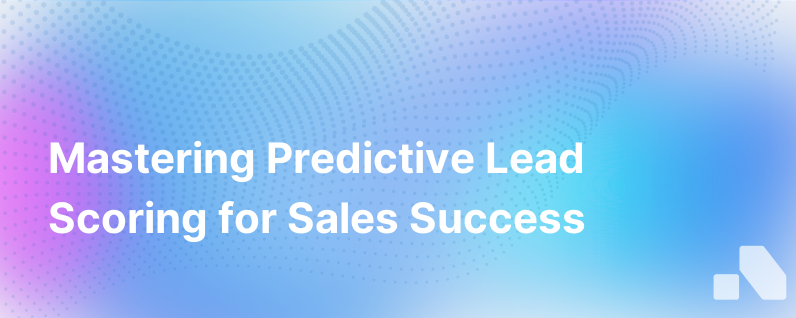
In the realm of B2B marketing and sales, the ability to accurately predict which leads are likely to turn into customers can be likened to having a crystal ball. Yet, even in the absence of such mystic objects, predictive lead scoring offers the next best thing, utilizing the power of data analytics and machine learning to forecast lead conversion likelihood. This approach not only sharpens your sales focus but also drives operational efficiency, paving the way toward a more streamlined revenue machine.
Understanding predictive lead scoring is vital for any business looking to optimize lead management processes in the digital age. Let's dive deep into the principles and practices of this revolutionary method.
Predictive Lead Scoring Explained
Predictive lead scoring is an advanced, data-driven method used to evaluate and rank leads based on their probability of converting into sales. Unlike traditional lead scoring, which relies on heuristic rules and assumptions assigned to various lead attributes and activities, predictive lead scoring employs algorithms and machine learning models to analyze vast amounts of data, discerning complex patterns and predicting outcomes with greater accuracy.
This analytical process examines a multitude of variables, including demographic information, online behaviors, engagement levels, and transaction histories, to provide a nuanced, predictive score for each lead. The result is a prioritized list of leads that enables sales and marketing teams to channel their efforts wisely.
The Importance of Predictive Lead Scoring
Astute businesses harness the power of predictive lead scoring for a host of benefits:
- Enhanced efficiency: By identifying the most promising leads, sales teams can allocate their time and resources to nurturing those with the highest propensity to close, streamlining the sales process.
- Increased conversion rates: By focusing on high-scoring leads, conversion rates naturally improve, leading to a healthier pipeline and a positive impact on the bottom line.
- Scalability: As your business grows, so too does the volume of incoming data. Predictive lead scoring automatically adapts to this increasing complexity, ensuring scalability in your lead management process.
- Objective decision-making: Human bias can inadvertently creep into manual lead scoring. Predictive lead scoring removes this subjectivity, relying instead on empirical data and statistical models.
The Predictive Lead Scoring Process
Predicting the future might not involve a crystal ball, but it does entail a methodical process bound by data science. Here's how it unfolds:
Data Collection and Integration
The first step in predictive lead scoring involves aggregating data from multiple sources—including CRM systems, web tracking tools, marketing automation platforms, and more. This all-encompassing view provides the foundational dataset needed for effective analysis.
Model Training and Validation
The next phase is to develop a predictive model using historical data. This model is run through a variety of algorithms that learn from past lead behaviors to identify patterns correlated with successful conversions. By testing and validating these models against known outcomes, their accuracy can be refined.
Scoring and Ranking Leads
Once the model is honed, it gets to work on current leads, assigning each a predictive score. These scores represent the leads' likelihood of advancing through the sales funnel and ultimately becoming customers.
Ongoing Refinement
Given that market conditions, customer behaviors, and product offerings can all change, a predictive lead scoring model is never truly finished. It requires periodic retraining and recalibration to stay current, much like how a navigator must continually adjust their course at sea.
The Role of AI and Machine Learning
Artificial Intelligence (AI) and machine learning are the backbone technologies behind predictive lead scoring. Machine learning algorithms effectively "learn" from patterns in the data, making complex decisions without being explicitly programmed for every possible scenario. As they process more data over time, these algorithms become smarter and more accurate in their predictions. This technological empowerment isn't just revolutionary; it's invaluable for maintaining a competitive edge in a dynamic marketplace.
Best Practices for Predictive Lead Scoring
Successfully implementing predictive lead scoring requires a thoughtful approach. Remember these best practices:
Ensure Data Quality
Predictive models are only as good as the data they learn from. Ensuring data accuracy and completeness is paramount for reliable scoring. Regular data audits can help maintain the integrity of your database.
Define Conversion Events
Understanding and defining what constitutes a successful conversion is critical for training your model. This could be a sale, an upsell, a renewal, or another metric specific to your business goals.
Integrate Cross-Departmental Insights
Collaboration across departments can enrich the data pool and provide a more holistic view of each lead, ultimately leading to more precise scoring.
Monitor Model Performance
Keep tabs on your model's performance metrics, such as precision, recall, and conversion lift, to measure effectiveness and identify areas for improvement.
The Aomni Edge: Predictive Lead Scoring Made Effortless
Navigating the complex waters of predictive lead scoring can be daunting, especially for teams without extensive data science experience. This is where Aomni bridges the gap. Aomni's AI-driven platform assists businesses in harnessing the full potential of predictive lead scoring, simplifying the entire process from data integration to scoring refinement. With Aomni, you're not just leveraging a tool; you're adopting a partner that grows and evolves with your business needs, ensuring that your lead management remains state-of-the-art with minimal effort required.
Predictive lead scoring is an inevitable step toward mature sales and marketing operations. It transforms lead management from guesswork into a precise, data-informed discipline. By embracing this technique, businesses are strategically positioning themselves not only to capture the leads of today but to anticipate the opportunities of tomorrow. As with any potent competitive tool, the key to mastery is not just in implementation, but in the continuous refining that adapts to an ever-shifting marketplace—all of which Aomni can facilitate as you chart your course through the data-driven depths of modern B2B sales.